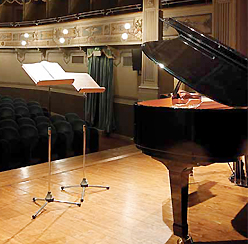There’s a great moment in Forbidden Planet where Morbius tells the young Leslie Nielsen, intrepid captain of starship C57D, that it is “time for clarification.”
The generationally challenged might want to check this flick out, as it is the progenitor of Star Trek, Star Wars – even certain aspects of Avatar.
“Clarification” in this case relates to the piano thing, as in a series of articles where I detailed a multi-mic technique for providing a very loud quad monitor mix for those who needed such.
I had no direct look at the more amusing LAB (Live Audio Board) responses to those articles, but during an alcohol-fueled evening at AES in San Francisco one year, a colleague read me some of the stuff, in between gales of laughter.
At the time I wondered how well the posters would have done with Dave Brubeck, Herbie Hancock, Chick Corea, Jerry Lee Lewis, McCoy Tyner, Pat Moraz, Randy Newman, Tom Waits, and all the others who got variations of this treatment. But, as HL Mencken said, there ain’t no such thing as bad publicity.
Mostly, however, I used between one and three mics, a point that I failed to emphasize at the time. We only went to high mic counts for those who needed max volume. You can get it fairly (though not as) loud with fewer mics, but it will be extremely difficult to get all the notes evened out in the monitors.
By slicing up the frequency spectrum into the presentations of multiple mics, you can achieve both high SPL and avoid holes and bumps between the keys.
Anyway, we are not here to revisit that turf. We are here to present three different single mic piano techniques, which will cover most normal piano situations.
None of these methods is original – I got the foam/high hole one from a colleague who himself copped it from his boss at Sirca Sound. The Sennheiser 421 semi-boundary trick came directly from John Lewis of the Modern Jazz Quartet, and the underneath soundboard move came from a Glenn Gould video.
With the exception of the 421 trick, these methods can be used as singles or in multi-mic situations, regardless of the status (or absence) of the lid.
It’s In The Hole
First up is the high hole method. Grand pianos have a brass plate above the wooden soundboard. Along the side with the higher strings, there will be a series of holes in the brass. A smaller grand might have five holes, while the big suckers will have a lot more.
Have someone bang at the keyboard, and listen (that is, bend over and get your ear as close as possible) to each hole. One of them will have a fuller representation of the instrument than the others – usually the two or three hole.

Note that the hole closest to the keys is the number 1 hole, with the numerical progression moving upwards away from the keyboard. Take a piece of foam, slap some tape on the bottom, and position it near the target hole in such a way that when the mic is placed on the foam the head just sticks out over the hole.
And that’s basically it. You will have to carefully tape the mic body to the foam, along with the XLR and the cable. Run the cable along the side of the piano to the end furthest from the keyboard, and dress it out there. Do not cover any of the holes with foam or tape – otherwise there’s not a lot that can go wrong here.
I was first told to use an old school Shure SM57 for this, and still do, when there’s nothing better around. Make sure to use the Shure supplied screen if you do this, as the 57 has a thing at 4.5 kHz that needs to be knocked down.
My preference for the single mic high hole look is the old school (not the new ones – no way) AKG 414 – there’s a little something there at 900 Hz or so that tarts up the response just enough to give the outcome musical detail absent in other mics.
Note in the accompanying photo that I used an Audio-Technica 4041, a thinner, more linear sound than the old 414, if somewhat less musical. For the money, the 4041 is the best deal going – you might want to check it out on cymbals, strings, percussion or just about anything aside from an amp or bass drum.




















